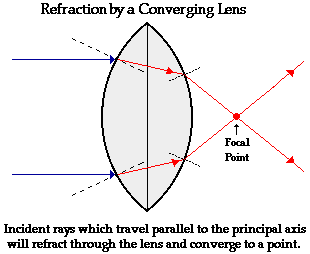
Refraction
Refraction is the change in direction of a wave, caused by the change in the wave's speed. Refraction is seen most often when a wave passes from one medium to a different medium. Different types of medium include air and water.
When a wave passes from one medium to another medium, the wave will change its speed and its direction. For example, when a light wave travels through air and then passes through water, the wave will slow and change direction.
As light travels through the refractive device, it will 'bend' toward the normal. When it leaves the refractive device to air (with a lower refractive index) it will return along the same angle as when it entered the device.
An example of how refraction works is placing a straw in a cup of water, with part of the straw in the water. When looking at a certain angle, the straw appears to bend at the water's surface. This is because of the bending of light rays as they move between the air and the water. Have you noticed how your body slows down when you try to walk through water? You go racing down the beach at top speed but, as soon as you hit the sea, you slow right down. No matter how hard you try, you cannot run as quickly through water as through air. The dense liquid is harder to push out of the way, so it slows you down. Exactly the same thing happens to light if you shine it into water, glass, plastic or another more dense material: it slows down quite dramatically. This tends to make light waves bend—something we call refraction.


How it Works
The limited light from the object will have to be magnified and projected on to an electronic sensor (CCD) . This means that a lens will have to be used and lenses use refraction of light for them work. Lenses work based on the concept of refraction. Refraction occurs only when light moves from one medium to another, provided the two media have different densities. Light travels at different speeds in different media. When the speed of light changes, the light ray bends. When light from an object hits the lens, it begins to move in glass instead of air. Light travels slower in glass. This change in velocity causes the light to bend. The bending of light results in a distortion in the image formed. The amount of distortion in the image depends on the distance of the lens from the object. Every lens has a focal point, which is the distance at which the lens can focus the light shining on it to a point. If the object is placed between the focal point of the lens and the lens itself, the image will look bigger than the actual object.
